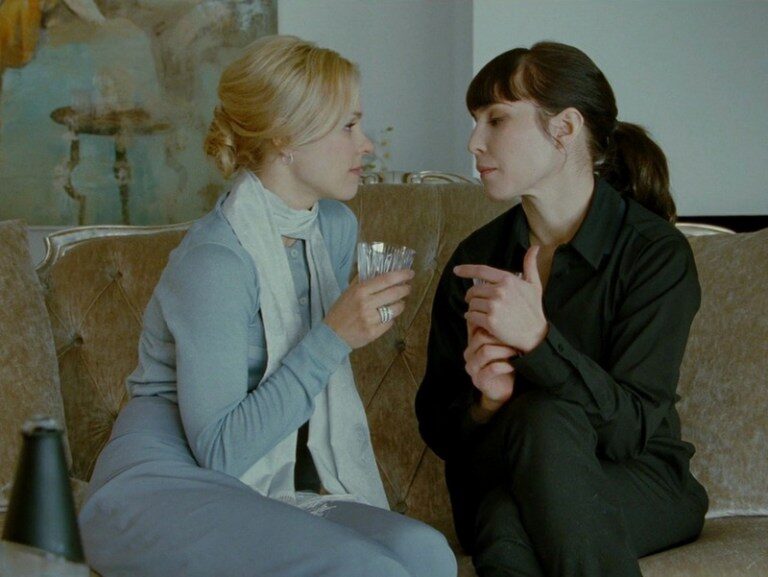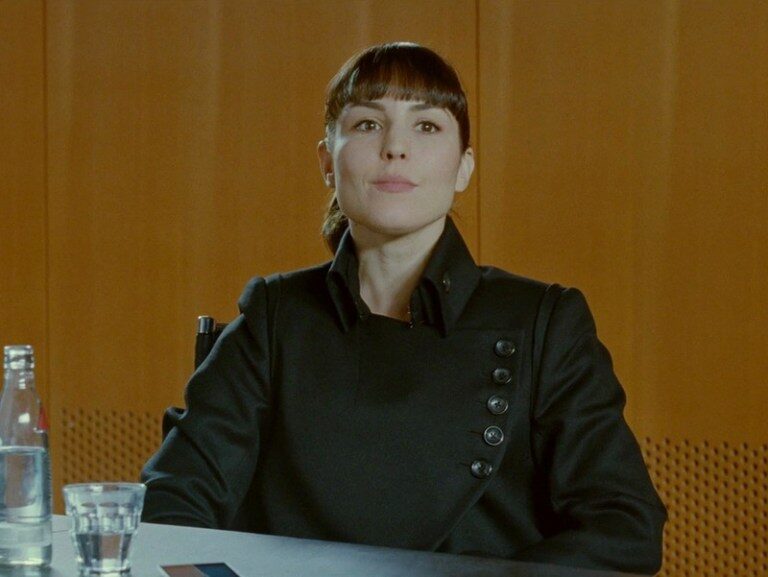Brian de Palma's Passion: Costume as Contemporary Hitchcock | http://clothesonfilm.net – Part 35434
Director Brian De Palma has made movies heavily influenced by Alfred Hitchcock before, but Passion (2012) is the first one whose characters look like they stepped out of one of Hitchcock’s classic films.
Karen Muller-Serreau’s bold and colourful costumes communicate the characters’ hidden desires and make watching Passion a sensory experience. This melodrama centres on two ad executives, Isabelle (Noomi Rapace) and her boss Christine (Rachel McAdams), who have a deadline to come up with an ad campaign for a new smartphone. In her sleep, Isabelle thinks of a great idea.
 Dirk (Paul Anderson) in typical pinstriped suit with Isabelle (Noomi Rapace) in even more typical black.
Dirk (Paul Anderson) in typical pinstriped suit with Isabelle (Noomi Rapace) in even more typical black.
The two other principal characters are Isabelle’s assistant Dani (Karoline Herfurth) and Christine’s boyfriend Dirk (Paul Anderson) who get tangled in the twists and turns of Christine and Isabelle’s relationship. Dani is an angel-faced redhead who is in unrequited love with her boss Isabelle, while scruffy-faced Dirk has an affair with Isabelle, and might even be in love with her. When Christine steals Isabelle’s idea to get a promotion, this sparks a fierce war of backstabbing where Christine and Isabelle battle for dominance.
As ad agency boss Christine, Rachel McAdams wears sleeveless sheath dresses and a lot of turtlenecks and palazzo pants, all in bold colours free of pattern from ice blue and blood red to cherry-vanilla and fuchsia. Ice-blonde Christine is a Grace Kelly lookalike who craves attention, usually wearing the most noticeable colour in the room; the solid colours help her stand out without patterns to get in the way.
 Christine (Rachel McAdams) is, according to the intentions of costume designer Karen Muller-Serreau, “contemporary Hitchcockian” with her style.
Christine (Rachel McAdams) is, according to the intentions of costume designer Karen Muller-Serreau, “contemporary Hitchcockian” with her style.
Muller-Serreau says she wanted to give Rachel a “contemporary Hitchcockian feeling with shapes that have a modern vintage style in bold colours.” Christine begins the film in an ice-blue shirt and palazzo pants combo topped off by a blueberry-vanilla coloured scarf tied artfully around her neck, while Isabelle’s black dress shirt and pants pop against the white walls and light-coloured furniture of Christine’s house. She has to be dominant so she gives the scarf as a gift to Isabelle, wrapping the blueberry-vanilla scarf around Isabelle’s neck; it stands out against her black coat.
The following morning, Christine struts her stuff down the path in her front yard in a double-breasted blood-red overcoat that would scare the bejeezus out of Tippi Hedren in Hitchcock’s Marnie (1964); Christine looks like a spoilt little rich girl about to be chauffeured to private school. If Christine sometimes looks like a child playing dress-up, there’s a scene late in the film where she wears a striking black overcoat worn with a wide-brimmed hat, round sunglasses and teal stiletto sandals. It’s a coat that Muller-Serreau wanted to look like a little girl’s coat, so she based it on a classic child’s coat since Christine’s twin sister died in childhood.
 Isabelle’s deliberately unusual black jacket with uniform button fastening.
Isabelle’s deliberately unusual black jacket with uniform button fastening.
Isabelle, the second-in-command, wears black for most of the film signalling her lack of identity. Since Muller-Serreau didn’t have colour to work with for Isabelle, she gave her shape and texture. There’s a suit jacket with heavy shoulder pads that hint at Joan Crawford in Mildred Pierce (1945) and a side-breasted military jacket she wears when she has the upper hand. Her Edith Head hairstyle, fringe and all, helps make her look like she stepped out of an old movie.
One particularly inspiring moment is when an angry, depressed Isabelle at an office reception wears a black dress shirt and pants with a black tie. Underneath the slightly sheer shirt is a black bra. She’s dressed in a stereotypical male outfit, but despite the butch quality of the outfit, she still wants to be desired sexually as a feminine woman. Muller-Serreau says Isabelle’s look was supposed to be a “uniform”, presenting Isabelle as a “soldier” — a soldier who wants to be seen as a sexy woman.
 Dani (Karoline Herfurth), the only character “who threatens Christine’s status as the most colourful in the room.”
Dani (Karoline Herfurth), the only character “who threatens Christine’s status as the most colourful in the room.”
While Isabelle wears only one colour, her assistant Dani wears many colors, and is the only person who threatens Christine’s status as the most colourful person in the room. She often wears animal prints and sometimes pairs it with clashing horizontal stripes. Her costumes are meant to garner attention, like the denim daisy dukes she wears paired with tights and knee-high stiletto boots, and an asymmetrically zipped purple leather motorcycle jacket. However, she also achieves elegance in a violet lace shirt. It’s a look Muller Serreau describes as “feminine and sexy” and that it’s a departure from the “butch lesbian cliché.”
Dirk wears braces with his pinstripe suits and checkered suits; the braces hark back to a much earlier era. His costumes consist of all suits, except for when he wears a tank top in his bedroom post-coital. Lying on a bed, his thin frame is more evident here, making him appear more vulnerable. He confesses secrets while smoking in a cigarette, becoming more feminine in his gestures and voice: he seems to be imitating Christine when he tells Isabelle that the blueberry-vanilla scarf looks better on her. It’s a perfect example of how men are emasculated in this film, and how the characters are much different in private.
 Dirk, vulnerable in his white tank top (vest).
Dirk, vulnerable in his white tank top (vest).
Brian De Palma is known for making operatic films that play like Shakespearean tragedies, and Passion is no exception. When a character takes a fall, it’s the result of a corrupt world. Isabelle began the film as a shy, naïve person who had to become more like the manipulative Christine to show her creative genius.
The film is also about rejection and how devastating it is to be on the receiving end of it. Isabelle rejects Christine and Dani for the whole movie, but she doesn’t reject Dirk; it is he who rejects her.
 Christine in fuchsia sheath – a vain attempt to own the room with colour.
Christine in fuchsia sheath – a vain attempt to own the room with colour.
Rachel McAdams builds on her previous roles as an antagonist — Regina George in Mean Girls (2004) and Inez in Midnight in Paris (2011) — but unlike those roles, Rachel doesn’t punctuate her zingers by turning her head away for comic effect; for Christine, she doesn’t turn away, but instead continues to watch, for anyone who dares to threaten her position. She is someone who tries her hardest to be the sophisticated boss in heels, but no one really buys it. However, her surface beauty and stylish clothes are mesmerizing, like a photo spread come to life that compels you to spend money on new clothes.
By having the characters look like they’re from another era, Karen Muller-Serreau supports De Palma’s vision of today’s culture of selfies, texting and organic food as conformity at its worst. De Palma pokes fun in one scene by showing Isabelle’s intense anticipation of a text from Dirk as the most important thing in the world, all the while dressed in her black suit jacket and Christine’s blueberry-vanilla scarf draped around her neck, wearing it like a child torn between two parents.
For anyone who thinks today’s culture of tweeting sexy selfies, and having the latest smart phone is ridiculous, then Passion is the perfect movie, and De Palma and Karen Muller-Serreau have done this by using classic filmmaking techniques and classic fashion styles.
By Christopher Cole
Chris loves movies about power dynamics and loves anything with people in clothes that look good enough to eat. Also some day he would love to live in Cher Horowitz’s big White House in Clueless. Chris has written about some of these things on his blog No Harm in Charm.
Screencapped images have been cropped to better highlight costume details.
© 2014, Lord Christopher Laverty.